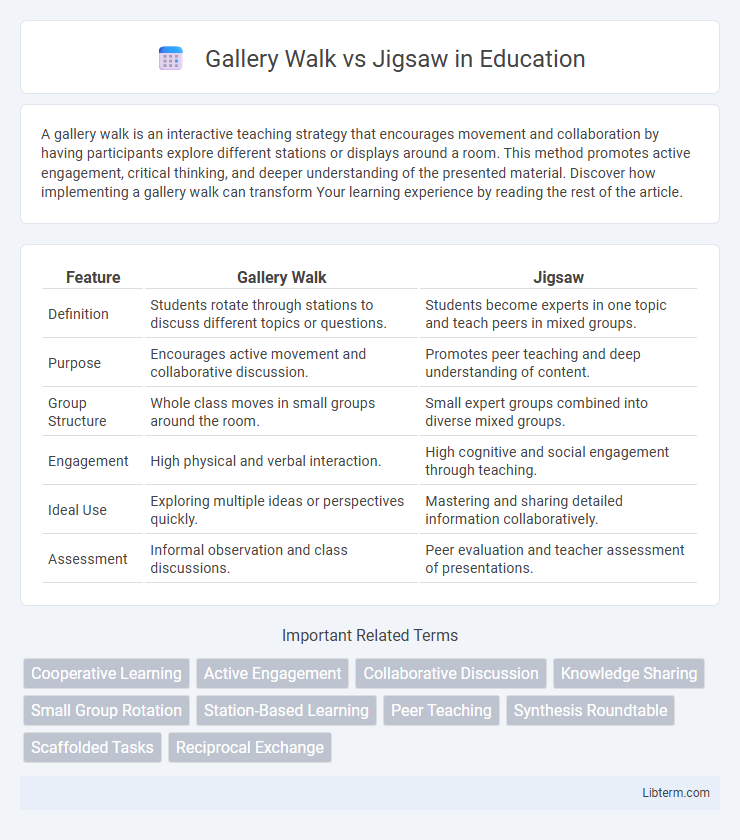A gallery walk is an interactive teaching strategy that encourages movement and collaboration by having participants explore different stations or displays around a room. This method promotes active engagement, critical thinking, and deeper understanding of the presented material. Discover how implementing a gallery walk can transform Your learning experience by reading the rest of the article.
Table of Comparison
| Feature | Gallery Walk | Jigsaw |
|---|---|---|
| Definition | Students rotate through stations to discuss different topics or questions. | Students become experts in one topic and teach peers in mixed groups. |
| Purpose | Encourages active movement and collaborative discussion. | Promotes peer teaching and deep understanding of content. |
| Group Structure | Whole class moves in small groups around the room. | Small expert groups combined into diverse mixed groups. |
| Engagement | High physical and verbal interaction. | High cognitive and social engagement through teaching. |
| Ideal Use | Exploring multiple ideas or perspectives quickly. | Mastering and sharing detailed information collaboratively. |
| Assessment | Informal observation and class discussions. | Peer evaluation and teacher assessment of presentations. |
Introduction to Collaborative Learning Strategies
Gallery Walk and Jigsaw are effective collaborative learning strategies designed to enhance student engagement and knowledge retention. Gallery Walk encourages movement and collective analysis by having students rotate around stations to discuss and evaluate different perspectives or concepts. Jigsaw fosters interdependence by dividing content into segments, assigning students to expert groups, then reassembling them into diverse teams to share expertise and build a comprehensive understanding.
Understanding the Gallery Walk Method
The Gallery Walk method enhances student engagement by allowing learners to move around the classroom and interact with various displays or posters, promoting active learning through observation and discussion. This technique fosters deeper understanding by encouraging collaboration, critical thinking, and reflection on different perspectives presented in the gallery. Unlike the Jigsaw method, which divides content among small expert groups, the Gallery Walk emphasizes collective exploration and visual learning across the entire class.
Exploring the Jigsaw Technique
The Jigsaw technique promotes collaborative learning by dividing students into expert groups to master specific content before teaching peers in mixed groups, enhancing comprehension and retention. This method fosters active engagement, communication skills, and accountability as each student's contribution is vital to the entire group's understanding. Exploring the Jigsaw approach reveals its effectiveness in diverse educational settings, supporting differentiated instruction and cooperative problem-solving among learners.
Key Differences Between Gallery Walk and Jigsaw
Gallery Walk involves students moving physically to explore different stations or displays, promoting active engagement and collaborative learning. Jigsaw divides the class into expert groups where each member learns a segment of the material and then teaches it to their peers, fostering interdependence and mastery of content. The primary difference lies in Gallery Walk's emphasis on visual interaction and mobility, while Jigsaw centers on segmented learning and peer teaching.
Benefits of Gallery Walk in the Classroom
Gallery Walk promotes active learning by encouraging students to move around, engage with diverse perspectives, and analyze content collaboratively. It enhances critical thinking through visual interaction and peer discussion, making complex topics more accessible and memorable. This method fosters a dynamic classroom environment, increasing student motivation and participation compared to traditional static learning techniques.
Advantages of the Jigsaw Approach
The Jigsaw approach promotes active collaboration by assigning each participant a unique piece of information, which enhances individual accountability and encourages cooperative learning. This method improves information retention and critical thinking as students must teach and learn from their peers. Jigsaw also fosters inclusivity by ensuring equal participation and maximizing engagement across diverse skill levels.
Challenges and Limitations of Each Method
Gallery Walk can face challenges such as time constraints and potential student passivity during observation, which may limit deep engagement. Jigsaw requires careful group composition and relies heavily on individual accountability; uneven participation can hinder the overall learning process. Both methods may struggle with assessing individual understanding amidst collaborative activities, demanding additional strategies to ensure equitable contribution and comprehension.
Practical Examples and Application Scenarios
Gallery Walk is ideal for brainstorming sessions and visual presentations where students move around the room to engage with different workstations, promoting active learning and peer feedback. Jigsaw suits collaborative learning environments that require students to become experts on specific topics before teaching their peers, enhancing comprehension and accountability. Both methods effectively encourage interaction, but Gallery Walk excels in exploring diverse ideas visually, while Jigsaw fosters deeper understanding through structured peer teaching.
Student Engagement and Learning Outcomes
Gallery Walk promotes active student engagement by encouraging movement, observation, and peer interaction, which enhances comprehension and retention of diverse perspectives. Jigsaw fosters collaborative learning by assigning students specific segments to master and teach, improving accountability and deep understanding of content. Both strategies boost critical thinking and communication skills, but Gallery Walk excels in dynamic participation, while Jigsaw emphasizes individual responsibility within group success.
Choosing the Right Strategy for Your Classroom
Gallery Walk enhances student engagement through movement and visual interaction with displayed work, making it ideal for kinesthetic learners and collaborative environments. Jigsaw promotes deep understanding by assigning each student a unique segment of information to master and teach peers, fostering accountability and interdependence. Selecting the right strategy depends on classroom objectives, student learning styles, and content complexity, with Gallery Walk suited for exploratory discussions and Jigsaw for detailed, cooperative learning.
Gallery Walk Infographic

 libterm.com
libterm.com